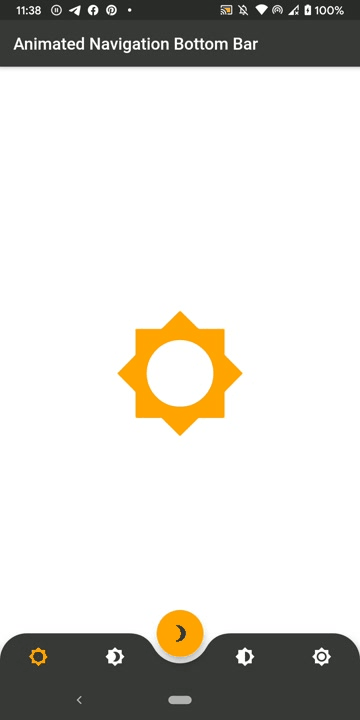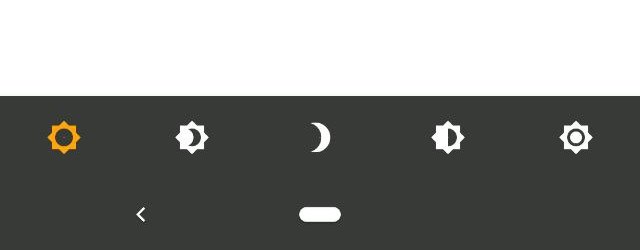Flutter动画底部导航栏插件animated_bottom_navigation_bar的使用
Flutter动画底部导航栏插件animated_bottom_navigation_bar的使用
简介
AnimatedBottomNavigationBar 是一个可定制的小部件,灵感来自于 Dribbble上的设计。它提供了丰富的自定义选项,可以轻松创建带有动画效果的底部导航栏。

快速开始
要开始使用 AnimatedBottomNavigationBar,只需将其放置在 Scaffold 的 bottomNavigationBar 插槽中。它会自动尊重 FloatingActionButton 的位置。例如:
Scaffold(
body: Container(), // 目标页面
floatingActionButton: FloatingActionButton(
onPressed: () {},
),
floatingActionButtonLocation: FloatingActionButtonLocation.centerDocked,
bottomNavigationBar: AnimatedBottomNavigationBar(
icons: iconList,
activeIndex: _bottomNavIndex,
gapLocation: GapLocation.center,
notchSmoothness: NotchSmoothness.verySmoothEdge,
leftCornerRadius: 32,
rightCornerRadius: 32,
onTap: (index) => setState(() => _bottomNavIndex = index),
),
);
你还可以通过 AnimatedBottomNavigationBar.builder 构建更灵活的 bottomNavigationBar:
Scaffold(
body: Container(), // 目标页面
floatingActionButton: FloatingActionButton(
onPressed: () {},
),
floatingActionButtonLocation: FloatingActionButtonLocation.centerDocked,
bottomNavigationBar: AnimatedBottomNavigationBar.builder(
itemCount: iconList.length,
tabBuilder: (int index, bool isActive) {
return Icon(
iconList[index],
size: 24,
color: isActive ? colors.activeNavigationBarColor : colors.notActiveNavigationBarColor,
);
},
activeIndex: _bottomNavIndex,
gapLocation: GapLocation.center,
notchSmoothness: NotchSmoothness.verySmoothEdge,
leftCornerRadius: 32,
rightCornerRadius: 32,
onTap: (index) => setState(() => _bottomNavIndex = index),
),
);
自定义
AnimatedBottomNavigationBar 支持 2、3、4 或 5 个导航元素,并且可以根据需要进行自定义。以下是一些常见的自定义示例:
平滑的圆角和缺口
Scaffold(
floatingActionButton: FloatingActionButton(
onPressed: () {},
),
floatingActionButtonLocation: FloatingActionButtonLocation.centerDocked,
bottomNavigationBar: AnimatedBottomNavigationBar(
icons: iconList,
activeIndex: _bottomNavIndex,
gapLocation: GapLocation.center,
notchSmoothness: NotchSmoothness.verySmoothEdge,
leftCornerRadius: 32,
rightCornerRadius: 32,
onTap: (index) => setState(() => _bottomNavIndex = index),
),
);

普通样式
Scaffold(
bottomNavigationBar: AnimatedBottomNavigationBar(
icons: iconList,
activeIndex: _bottomNavIndex,
onTap: (index) => setState(() => _bottomNavIndex = index),
),
);

圆角样式
Scaffold(
bottomNavigationBar: AnimatedBottomNavigationBar(
icons: iconList,
activeIndex: _bottomNavIndex,
leftCornerRadius: 32,
rightCornerRadius: 32,
onTap: (index) => setState(() => _bottomNavIndex = index),
),
);

驱动导航栏变化
要程序化地更改活动的导航栏标签,可以通过传递新的 activeIndex 来实现:
class _MyAppState extends State<MyApp> {
int activeIndex = 0;
void _onTap(int index) {
setState(() {
activeIndex = index;
});
}
@override
Widget build(BuildContext context) {
return Scaffold(
bottomNavigationBar: AnimatedBottomNavigationBar(
activeIndex: activeIndex,
onTap: _onTap,
),
);
}
}
完整示例代码
以下是包含所有功能的完整示例代码:
import 'package:animated_bottom_navigation_bar/animated_bottom_navigation_bar.dart';
import 'package:flutter/material.dart';
void main() => runApp(MyApp());
class MyApp extends StatelessWidget {
@override
Widget build(BuildContext context) {
return MaterialApp(
title: 'Flutter Demo',
theme: ThemeData.light(),
darkTheme: ThemeData.dark(),
home: MyHomePage(title: 'Animated Navigation Bottom Bar'),
);
}
}
class MyHomePage extends StatefulWidget {
MyHomePage({Key? key, required this.title}) : super(key: key);
final String title;
@override
_MyHomePageState createState() => _MyHomePageState();
}
class _MyHomePageState extends State<MyHomePage> with TickerProviderStateMixin {
int _bottomNavIndex = 0;
late AnimationController _fabAnimationController;
late AnimationController _borderRadiusAnimationController;
late Animation<double> fabAnimation;
late Animation<double> borderRadiusAnimation;
late CurvedAnimation fabCurve;
late CurvedAnimation borderRadiusCurve;
late AnimationController _hideBottomBarAnimationController;
final iconList = <IconData>[
Icons.brightness_5,
Icons.brightness_4,
Icons.brightness_6,
Icons.brightness_7,
];
@override
void initState() {
super.initState();
_fabAnimationController = AnimationController(
duration: Duration(milliseconds: 500),
vsync: this,
);
_borderRadiusAnimationController = AnimationController(
duration: Duration(milliseconds: 500),
vsync: this,
);
fabCurve = CurvedAnimation(
parent: _fabAnimationController,
curve: Interval(0.5, 1.0, curve: Curves.fastOutSlowIn),
);
borderRadiusCurve = CurvedAnimation(
parent: _borderRadiusAnimationController,
curve: Interval(0.5, 1.0, curve: Curves.fastOutSlowIn),
);
fabAnimation = Tween<double>(begin: 0, end: 1).animate(fabCurve);
borderRadiusAnimation = Tween<double>(begin: 0, end: 1).animate(borderRadiusCurve);
_hideBottomBarAnimationController = AnimationController(
duration: Duration(milliseconds: 200),
vsync: this,
);
Future.delayed(Duration(seconds: 1), () => _fabAnimationController.forward());
Future.delayed(Duration(seconds: 1), () => _borderRadiusAnimationController.forward());
}
bool onScrollNotification(ScrollNotification notification) {
if (notification is UserScrollNotification && notification.metrics.axis == Axis.vertical) {
switch (notification.direction) {
case ScrollDirection.forward:
_hideBottomBarAnimationController.reverse();
_fabAnimationController.forward(from: 0);
break;
case ScrollDirection.reverse:
_hideBottomBarAnimationController.forward();
_fabAnimationController.reverse(from: 1);
break;
case ScrollDirection.idle:
break;
}
}
return false;
}
@override
Widget build(BuildContext context) {
return Scaffold(
extendBody: true,
appBar: AppBar(
title: Text(widget.title),
),
body: NotificationListener<ScrollNotification>(
onNotification: onScrollNotification,
child: NavigationScreen(iconList[_bottomNavIndex]),
),
floatingActionButton: FloatingActionButton(
child: Icon(Icons.brightness_3),
onPressed: () {
_fabAnimationController.reset();
_borderRadiusAnimationController.reset();
_borderRadiusAnimationController.forward();
_fabAnimationController.forward();
},
),
floatingActionButtonLocation: FloatingActionButtonLocation.centerDocked,
bottomNavigationBar: AnimatedBottomNavigationBar.builder(
itemCount: iconList.length,
tabBuilder: (int index, bool isActive) {
final color = isActive ? Colors.blue : Colors.grey;
return Column(
mainAxisSize: MainAxisSize.min,
mainAxisAlignment: MainAxisAlignment.center,
children: [
Icon(
iconList[index],
size: 24,
color: color,
),
const SizedBox(height: 4),
Padding(
padding: const EdgeInsets.symmetric(horizontal: 8),
child: Text(
"brightness $index",
maxLines: 1,
style: TextStyle(color: color),
),
)
],
);
},
backgroundColor: Colors.white,
activeIndex: _bottomNavIndex,
splashColor: Colors.blue,
notchAndCornersAnimation: borderRadiusAnimation,
notchSmoothness: NotchSmoothness.defaultEdge,
gapLocation: GapLocation.center,
leftCornerRadius: 32,
rightCornerRadius: 32,
onTap: (index) => setState(() => _bottomNavIndex = index),
hideAnimationController: _hideBottomBarAnimationController,
shadow: BoxShadow(
offset: Offset(0, 1),
blurRadius: 12,
spreadRadius: 0.5,
color: Colors.blue.withOpacity(0.3),
),
),
);
}
}
class NavigationScreen extends StatelessWidget {
final IconData iconData;
NavigationScreen(this.iconData);
@override
Widget build(BuildContext context) {
return Container(
color: Theme.of(context).colorScheme.background,
child: ListView(
children: [
SizedBox(height: 64),
Center(
child: Icon(
iconData,
color: Colors.blue,
size: 160,
),
),
],
),
);
}
}
这个示例展示了如何使用 AnimatedBottomNavigationBar 创建一个带有动画效果的底部导航栏,并根据用户交互更新导航栏的状态。希望这些信息对你有所帮助!
更多关于Flutter动画底部导航栏插件animated_bottom_navigation_bar的使用的实战系列教程也可以访问 https://www.itying.com/category-92-b0.html
更多关于Flutter动画底部导航栏插件animated_bottom_navigation_bar的使用的实战系列教程也可以访问 https://www.itying.com/category-92-b0.html
当然,以下是如何在Flutter项目中使用animated_bottom_navigation_bar插件来创建带有动画效果的底部导航栏的示例代码。
首先,确保你已经在pubspec.yaml文件中添加了animated_bottom_navigation_bar依赖项:
dependencies:
flutter:
sdk: flutter
animated_bottom_navigation_bar: ^x.y.z # 请替换为最新版本号
然后运行flutter pub get来获取依赖项。
接下来是完整的示例代码,展示了如何使用animated_bottom_navigation_bar插件:
import 'package:flutter/material.dart';
import 'package:animated_bottom_navigation_bar/animated_bottom_navigation_bar.dart';
void main() {
runApp(MyApp());
}
class MyApp extends StatelessWidget {
@override
Widget build(BuildContext context) {
return MaterialApp(
title: 'Flutter Animated Bottom Navigation Bar Example',
theme: ThemeData(
primarySwatch: Colors.blue,
),
home: MyHomePage(),
);
}
}
class MyHomePage extends StatefulWidget {
@override
_MyHomePageState createState() => _MyHomePageState();
}
class _MyHomePageState extends State<MyHomePage> with SingleTickerProviderStateMixin {
int _selectedIndex = 0;
final List<Widget> _widgetOptions = <Widget>[
Center(child: Text('Home')),
Center(child: Text('Search')),
Center(child: Text('Profile')),
];
void _onItemTapped(int index) {
setState(() {
_selectedIndex = index;
});
}
@override
Widget build(BuildContext context) {
return Scaffold(
body: _widgetOptions.elementAt(_selectedIndex),
bottomNavigationBar: AnimatedBottomNavigationBar(
icons: [
Icons.home,
Icons.search,
Icons.person,
],
activeColor: Colors.blue,
inactiveColor: Colors.grey,
backgroundColor: Colors.white,
notchSmoothness: NotchSmoothness.defaultEdge,
notchWidth: 24.0,
height: 56.0,
animationDuration: 300,
currentIndex: _selectedIndex,
onTap: _onItemTapped,
),
);
}
}
代码解释
-
依赖项:
- 确保在
pubspec.yaml中添加了animated_bottom_navigation_bar依赖项。
- 确保在
-
MaterialApp:
- 使用
MaterialApp作为应用程序的根组件,并设置主题。
- 使用
-
MyHomePage:
- 创建一个包含三个页面的主页面,每个页面显示不同的文本。
- 使用
StatefulWidget来管理页面索引状态。
-
_onItemTapped:
- 定义一个方法来处理底部导航栏项的点击事件,并更新当前页面索引。
-
AnimatedBottomNavigationBar:
- 使用
AnimatedBottomNavigationBar作为底部导航栏,并配置以下属性:icons:底部导航栏项的图标。activeColor:选中项的颜色。inactiveColor:未选中项的颜色。backgroundColor:底部导航栏的背景颜色。notchSmoothness:切口的平滑度。notchWidth:切口的宽度。height:底部导航栏的高度。animationDuration:动画持续时间。currentIndex:当前选中的索引。onTap:点击事件处理函数。
- 使用
这样,你就可以在Flutter项目中实现带有动画效果的底部导航栏了。希望这个示例代码对你有所帮助!










